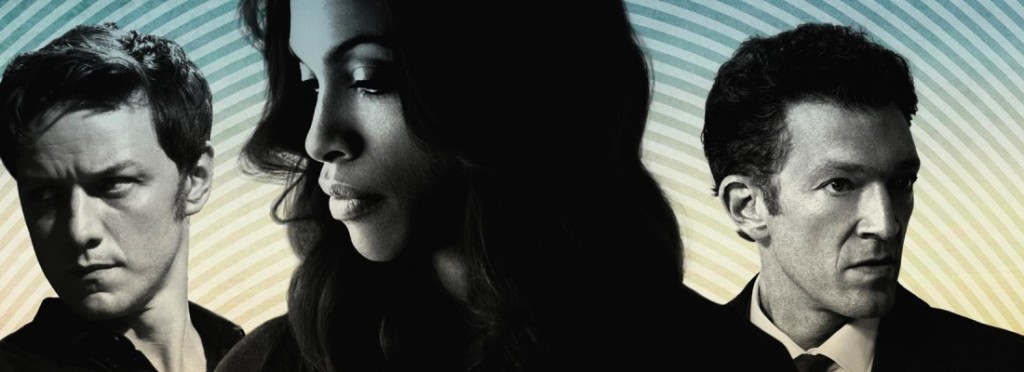starring: James McAvoy, Rosario Dawson, Vincent Cassel
screenplay: John Hodge and Joe Ahearne
directed by: Danny Boyle
MPAA: Rated R for sexual content, graphic nudity, violence, some grisly images, and language
Trance is the kind of movie we would have referred to as a “techno thriller” in the ’90s. It is skillfully directed by Danny Boyle, who helped shape this oeuvre with the pounding electronic soundtracks and post-MTV visual sensibilities of his first two films, Shallow Grave and Trainspotting; Boyle was an early master at constructing feature-length films that seemed to follow the hypnotizing rises and falls of taking ecstasy and going to a rave (or so I’ve heard), movies that built to frenetic and sustained peaks before graciously giving way to warm, dreamy mellows that still left you a bit wired. It is appropriate that Trance marks a reunion between Boyle and screenwriter John Hodge, who wrote Boyle’s first four films, and who is collaborating with him here for the first time since The Beach (2000). There have certainly been elements of Boyle’s ’90s roots in his ensuing work, but never so overtly as in Trance. Even the title is a bit of ’90s wordplay: “trance” refers to the hypnosis that plays a huge role in the plot, as well as the style of electronic music that peaked in the ’90s. While this all makes for some fun Run Lola Run-era nostalgia, Trance has an overall pre-millennial vibe that leaves the whole film feeling dated and a bit stale. It is also hilariously convoluted, but we’ll get to that later.
A decently engrossing but very silly hybrid of Inception and Eternal Sunshine of the Spotless Mind, Trance tells the pretzel-twisted story of Simon (James McAvoy), a fine art auctioneer mixed up in some bad shit. As a way of repaying a debt he owes to a thuggish gang led by the scowling Franck (Vincent Cassel), Simon agrees to help them steal an extremely valuable painting worth upwards of 25 million pounds. [Sidebar: art theft will never be interesting. Ever. Ever ever ever. Stop it, movies.] There’s just one problem with the plan: when the time comes, the painting isn’t where Simon said it would be. And what’s worse, Simon sustained a head injury during the melee that gave him a severe case of short-term memory loss. He has no recollection of what he did with the painting, or why he changed the plan at the last minute. And since British gangs aren’t generally ranked very high on Buzzfeed’s lists of the World’s Most Cuddly and Forgiving Criminals, Franck and Co. have no intention of accepting “I can’t remember because you gave me a brain injury” as an excuse.
They somehow settle on the idea of extracting the information using hypnosis, and when a list of hypnotherapists is placed before Simon, he unsurprisingly chooses the one with a picture that looks like Rosario Dawson: Dr. Elizabeth Lamb (Rosario Dawson). Simon dons a wire and begins having highly-coded sessions with Elizabeth (he can’t say what he’s actually looking for) while the gang listens in a van outside. But Elizabeth quickly figures out what’s happening, and soon introduces herself to Franck with an offer to help them crack Simon’s memory loss if they’ll drop the bullshit and make her a full financial partner. But if the film’s many reflective and/or distorted surfaces don’t sufficiently symbolize this for you, duplicity is afoot and the lines between dreams and reality are rapidly blurred.
Most films require some suspension of disbelief from the viewer, but Trance requires an entire suspension bridge. By the time all has been revealed, Trance has taken what could accurately be described as a science fiction approach to creating an entire mental health mythology all its own. One pictures Hodge and co-writer Joe Ahearne bouncing ideas off one another: “Well, but what if this happened, and then he did this, and then we could say he thought this because his brain did this! And why? BECAUSE HYPNOSIS!” The absurdities pile up the further Trance weaves down its wildly circuitous path to resolution. But no matter how confusing things get, rest assured when I say that all will be revealed. Rather than a few strategic flashbacks and some key voiceovers, Trance practically starts all over again when the Big Explanation comes.
And although the pace drags a bit after the adrenaline-pumping opening act, Trance eventually recovers its momentum and gradually builds to an explosively extended climax. There is plenty here to hold the audience’s more primitive and prurient interests, from outré flashes of over-the-top violence to Dawson appearing nude in a more revealing way than almost any established American actress has ever appeared nude onscreen before. Let’s just say that if Seth MacFarlane ever writes a full-frontal sequel to “We Saw Your Boobs,” Dawson should get an entire verse dedicated to her work in this film. McAvoy throws himself headlong into the madness required of his character, and Cassel glowers forebodingly per usual. And scandal aside, this is one of the richest roles Dawson has played in quite some time (too bad her performance will be overshadowed by the gratuitous nudity, which was really the point of MacFarlane’s song, not that anyone seems to care about that). It’s nothing new, but Trance is at least a fairly engaging retread of stylized ’90s U.K. suspense from one of its masters.
Trance opens in San Francisco on Friday, April 12.





